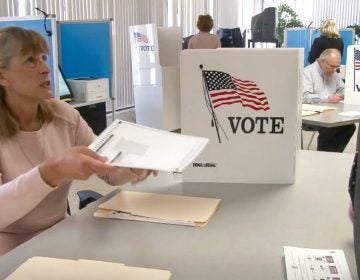Twitchy touchscreens, tiny font, button confusion: Did Philly’s new voting machines pass their test?
From twitchy touchscreens to tiny fonts, the city’s new devices ran into some issues, but most voters found them easy to use.

There were lots of demonstrations of the new Philly voting machines, but not everyone got a chance to try them before Election Day. (Emma Lee/WHYY)
Mayor Jim Kenney’s first experience using Philly’s brand-spanking-new touchscreen voting machines? Positive.
“That was great, pretty easy, actually,” the mayor told WHYY after casting his vote in the Nov. 5 general election. “I was a little concerned about how they would work out the first time out, and they seem to be fine, a pretty easy process.”
Some voters agreed with Philly’s mayor. But people all over the city have reported issues with voting via the new devices.
Nick Custodio, a staffer in the City Commissioners office, which oversees elections, said he didn’t think the new system was making much of a difference in the type of complaints his office was fielding.
“The same stuff that normally dominates, dominated today,” Custodio said, “Election judges oversleeping, stuff like that. From our perspective this has been a normal election.”
To use the virgin voting machines, which cost the city roughly $30 million — and were rushed into place so they could be tested before the presidential referendum in 2020 — voters inserted a blank paper ballot and then made selections on a touchscreen. Their choices were printed onto that paper ballot, which was then presented to them for an accuracy check before the final OK.
It might sound easy enough — and for many voters, it was. But some Philadelphians ran into complications.
Paper ballots come with their own issues
The idea behind the paper ballots is that they provide more accountability, since they leave a paper trail that can be audited — but they did present some confusion.
Germantown resident Jorge Brito said he heard the paper didn’t arrive on time to his polling place. About a dozen people had to wait in line until the equipment was delivered, he said, and election officials didn’t let people start voting until around 7:35 a.m. — more than a half hour after the polls opened.
Custodio, of the City Commissioners office, attributed problems like these to confusion about where the materials were stored. Poll workers didn’t receive the ballots separately — they were inside the back of the machine itself.
“We have had several people, that when the technicians got there, they were like, ‘Oh, they had their paper ballots,” Custodio said.
Yikes! Ballots should have been in the machines! 😬😬😬
— Kim Jordan (@kimlovestrees) November 5, 2019
For my division, we found the machines easy to set up and we were glad not to have broken machines like in the last few elections that caused lines & delays
The paper ballot system also created confusion for people used to pressing “vote” just once under older voting systems. The newer machines require voters to push the button twice.
The first press submits the on-screen picks to the machine, which then prints them onto the paper ballot and ejects a hard copy for review. Voters must then press this button again to confirm the correct choices were reflected on the paper. That last step is necessary in order for a vote to count and be tallied.
But in the city’s 18th Ward, which covers parts of Fishtown and Kensington, minority inspector Monica King said some voters simply walked away after the paper ballot was ejected for review.
“After their paper ballot is spit out,” King said, “they’re leaving the booth without confirming their vote.” She noted that at least one ballot had to be invalidated by poll workers after a voter walked away without pressing the confirmation button a second time.
“Thankfully we learned from that early mistake,” she said. “Now the machine inspectors are making sure that everybody has cast their ballot before they leave.”
voter reports touching Democratic candidate and republican candidate lights up pic.twitter.com/PFRdvLXCk5
— Tom MacDonald–WHYY (@TMacDonaldWHYY) November 5, 2019
Are the touchscreens too sensitive?
King also said election workers in her division had to tell voters to roll up their shirt and coat sleeves to avoid overly sensitive touchscreens.
“People’s puffy coats are causing them to select or deselect candidates when they rub against the screen,” the inspector told WHYY. “It just happened with an older woman in the booth. She almost spoiled her ballot and she didn’t know what was going on. We realized it was her coat.”
At least three other voters had similar problems, per King, all traced to coat sleeves or shirt cuffs brushing against the screens. Voter Michele Harper also described machines automatically changing her votes when she visited the polls.
“When I hit all Democrat, it changed all my votes to Republican,” said Harper, who cast her vote at Academy House on Locust near 15th Street. “Every one, all down the line.”
“Do our votes count?” she wondered at the time. “This is terrifying.”
Luckily, Harper noticed before she submitted an incorrect ballot. She called out to the poll workers, who helped her manually adjust her selections.
The City Commissioners office checked in with the judge of elections at Academy House where Harper voted, per staffer Custodio, who said they found any machine issues there could be attributed to human error.
When the font is too small — or too big
Mark Feinstein, who voted at Peirce College in Center City, navigated the new machines with a few hiccups — some of which he thinks could impact other older voters.
Among the issues: the font size on the printed ballot. Feinstein had trouble reviewing his selections because the voting booth was dimly lit, he said, and he couldn’t make out the small type.
“That’s brutal for most,” Feinstein said. “I could barely read it.”
Small font aside, Feinstein also said it was hard for him to choose all the candidates he wanted because of crowding.
“Why have so many contests on the same screen?” Feinstein added. “I figured it out, but it takes longer versus a new screen for each category. I can see senior citizens or others missing some contests.”
Custodio said all poll workers were trained to help voters increase or decrease the machine’s font size to their liking — there is even a “night mode” that can be enabled for sensitive eyes during evening polling hours.
But King, from the 18th Ward in Fishtown, said voters themselves were rarely aware of these facts or knew to ask for help resizing the ballot. Worse, when poll workers at her division did help a voter enlarge the font size on a machine, it only created more problems.
“The problem is instead of a two-page ballot, the ballot becomes 32 pages,” King said. “The voter asked the machine inspector to change it back to the regular font.”
Like ordering lunch at Wawa
Not all first-time experiences were negative. By and large, most voters were able to figure out the unfamiliar machines.
Karin, a 72-year-old Mount Airy resident who declined to give her last name, said although it took her a little longer, she was able to cast her vote. She compared the new voting system to the touchscreen sales kiosks at Wawa.
Others found the screens intuitive. Nicetown voter Andrea Akins said the machines worked fine for her — although her elderly mother was a bit confused. “I had to step in and kind of walk my mom through it,” she said.
Katie Coble, 31, voted in Norris Square. She said she found the new machines more trustworthy than the old system.
“I found it to be easier to use,” she said. “Before the buttons were kind of hard to know if you pushed them and so the touch screen made everything really clear and you also had confirmation with your paper ballot that everything you pushed was correct.
Hope Herbert voted in Holmesburg. She wasn’t crazy about the new machines, but said they weren’t hard to figure out. “It’s the new age, we all got to adapt to what’s going on,” she said.
“It’s just the way the world is — everything is digital, so you gotta go with the flow or be left behind. If you know how to work a computer, it’s nothing but tapping a button.”
—
WHYY’s Darryl C. Murphy, Catalina Jaramillo and Tom MacDonald and Billy Penn’s Max Marin contributed reporting.
WHYY is your source for fact-based, in-depth journalism and information. As a nonprofit organization, we rely on financial support from readers like you. Please give today.







